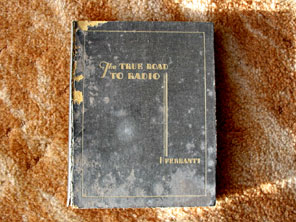|












| |
Ferranti Nova
 Although not one of the biggest names in radio, Ferranti
certainly has claim to being one of the oldest. Ferranti was founded way back in
1882 by Sebastian Ziani de Ferranti, although of course in those early days
radio transmission was not yet understood. However Ferranti was already
researching into electrical and telegraphic properties, indeed the year 1885 saw
him (and George Addenbrooke) granted a patent (No 14917) for improvements in
telegraphy and telephony by use of transformers. Ferranti himself died in 1930,
but by then the Ferranti company was already producing radio receivers. The
picture right shows the book "The True Road To Radio", a volume first
published in the late 1920's. This book explains all the main principles of
radio reception including the various stages of a radio receiver, as well as
examples of the calculations necessary to derive the data with which to
construct components like transformers from first principles. With illustrations
of receivers and components from Ferranti of those important years it now forms
a valuable reference work, and is much sought after. Although not one of the biggest names in radio, Ferranti
certainly has claim to being one of the oldest. Ferranti was founded way back in
1882 by Sebastian Ziani de Ferranti, although of course in those early days
radio transmission was not yet understood. However Ferranti was already
researching into electrical and telegraphic properties, indeed the year 1885 saw
him (and George Addenbrooke) granted a patent (No 14917) for improvements in
telegraphy and telephony by use of transformers. Ferranti himself died in 1930,
but by then the Ferranti company was already producing radio receivers. The
picture right shows the book "The True Road To Radio", a volume first
published in the late 1920's. This book explains all the main principles of
radio reception including the various stages of a radio receiver, as well as
examples of the calculations necessary to derive the data with which to
construct components like transformers from first principles. With illustrations
of receivers and components from Ferranti of those important years it now forms
a valuable reference work, and is much sought after.

The first Ferranti radio production works was at
Stalybridge, and in 1935 the company moved to premises at Moston near  Manchester
where they remained until 1956 (when the company was taken over). The receiver
pictured left is the Nova Consolette from
1936. This receiver is encased in a very distinctive bakelite cabinet, which has
obvious similarities with the Chrysler building of New York pictured right, also built about
the same time. The similarities are particularly evident in the ridged sides as
they reach the top of the cabinet. The tuning scale is simulated Mother Of
Pearl, and three of the knobs have chrome inserts resulting in a very stylish
set with obvious Art Deco associations. The little window above the tuning scale
is the Ferranti Magnascopic Tuning system, whereby the short wave wavelength was
projected onto a translucent screen by use of lamps and mirrors. The distinctive
cabinet, often referred to as the Ferranti "Jelly Mould", was to
reappear after WWII as the model 145. By 1945 the cabinet was looking somewhat
dated, and it is near certain that the cabinet style was only used again due to
lingering wartime constraints. Nonetheless, like the pre-war Nova, the 145 is
now very collectable, even though the 145 is a lot more common than the pre-war
Nova. Manchester
where they remained until 1956 (when the company was taken over). The receiver
pictured left is the Nova Consolette from
1936. This receiver is encased in a very distinctive bakelite cabinet, which has
obvious similarities with the Chrysler building of New York pictured right, also built about
the same time. The similarities are particularly evident in the ridged sides as
they reach the top of the cabinet. The tuning scale is simulated Mother Of
Pearl, and three of the knobs have chrome inserts resulting in a very stylish
set with obvious Art Deco associations. The little window above the tuning scale
is the Ferranti Magnascopic Tuning system, whereby the short wave wavelength was
projected onto a translucent screen by use of lamps and mirrors. The distinctive
cabinet, often referred to as the Ferranti "Jelly Mould", was to
reappear after WWII as the model 145. By 1945 the cabinet was looking somewhat
dated, and it is near certain that the cabinet style was only used again due to
lingering wartime constraints. Nonetheless, like the pre-war Nova, the 145 is
now very collectable, even though the 145 is a lot more common than the pre-war
Nova. Continue for more of the Ferranti
Nova
© COPYRIGHT RETAINED ON ALL TEXT AND PICTURES ON THIS SITE.
|







